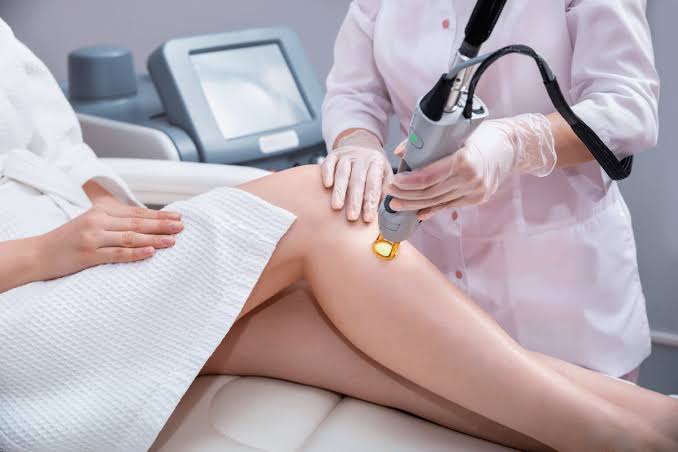Hair removal through laser uses concentrated light beams to penetrate the skin and absorb melanin from hair follicles to heat up and stop future hair development. This highly accurate procedure allows practitioners to target multiple follicles in a single session, making it efficient and effective.
It is a quick process, taking just a few minutes for small areas and up to an hour for larger ones. This technique can be used on the face, bikini area, arms, legs, back, and underarms.
Most people need more than one session to get the best results because lasers work best during specific phases of hair growth cycles. Six to eight sessions are usually advised.
Key Takeaways
- A long-term approach to slowing down hair growth is laser hair removal.
- There are prevalent misconceptions about the safety and efficiency of laser hair removal.
- Understanding the process and benefits can help individuals make informed decisions.
Benefits of Laser Hair Removal
For those wishing to get rid of unwanted hair, the famous cosmetic technique of laser hair removal offers various benefits. Because laser hair reduction targets the pigments in the hair follicle, it can permanently reduce or eradicate unwanted hair on the face, legs, underarms, and other areas.
Long-term results are one of the critical advantages of this therapy; many patients report smooth, hairless skin for months or even years following a single session. In addition, it is a comparatively quick, painless process with little recovery time. Its ability to target specific body parts enhances its customization potential. It provides a secure and efficient way to achieve smooth, blemish-free skin.
Common Misconceptions
A common misconception is that it is uncomfortable because laser hair removal lacks cooling devices. However, modern devices have improved the experience, resulting in minimal pain and quick relief after the procedure.
Additionally, the process is considered safe when performed by a certified professional skilled in using the equipment properly and tailoring the treatment to the patient’s skin tone and hair color.
Regulatory bodies like the FDA have certified their safe use to guarantee the efficacy and safety of laser hair removal technologies. Most side effects, such as slight redness or swelling, are short-lived and typically decrease within a few hours to a few days.
Preparing for Laser Hair Removal Sessions
Preparation is critical to getting the most out of your laser hair removal treatments. Here are some essential tips:
- Shave the target area 24 hours before the appointment to ensure the laser can focus on the hair follicle. Shaving helps minimize potential skin damage while maximizing the laser’s effectiveness.
- To optimize laser efficiency, prevent sun exposure and tanning two weeks before the session due to increased skin sensitivity and pigment interference.
- Avoid waxing or plucking for at least six weeks before the session to ensure proper hair growth in the follicle for effective treatment.
- Discuss your medications with your technician to avoid skin sensitivity. Certain drugs, like those causing photosensitivity, may require medical approval to discontinue before treatment.
Who is a Good Candidate?
Laser hair removal is helpful for many people but is especially advantageous for individuals with darker and lighter skin. It occurs because the laser focuses on the pigment within the hair. Yet, technological developments are enhancing its efficacy for various skin and hair types, too.
Professionals can now modify laser settings to safely and efficiently cater to a broader range of people. Therefore, people with different hair and skin tones can now use these services through specialized clinics with advanced technology.
Finally, scheduling a consultation with an expert laser hair removal specialist is critical to determine your fit. They will evaluate your hair and skin type to create a customized treatment plan for the best outcomes.
Aftercare Tips for Best Results
Aftercare is crucial to guarantee the most significant outcomes and reduce any possible negative consequences. Here are some recommendations:
- Apply aloe vera or soothing lotion to the treated area to alleviate redness or swelling. It helps to chill and soothe the skin after treatment.
- Avoid strenuous activities that provoke sweating for 24 hours, as it will irritate the treated area. Increased friction and heat can exacerbate sensitivity, leading to discomfort.
- Keep the treated area out of direct sunlight for at least two weeks after treatment, and protect your skin with sunscreen. Ultraviolet rays can cause hyperpigmentation in treated regions, disrupting skin tone uniformity.
- Follow all post-treatment guidelines given by your technician to ensure optimal results. Adhering to professional advice increases the likelihood of successful, long-lasting hair reduction.
Conclusion
In conclusion, laser hair removal stands as a significant advancement in the realm of aesthetic treatments. Its efficacy in reducing unwanted hair growth is backed by substantial scientific evidence, and its popularity continues to rise due to its convenience and long-term benefits. However, separating the hype from the help involves understanding both its capabilities and limitations. While laser hair removal can provide lasting results and reduce the hassle of constant shaving or waxing, it is not a one-size-fits-all solution and may require multiple sessions to achieve optimal outcomes.
Prospective patients should consult with certified professionals to assess their suitability for the treatment and to develop a personalized plan that aligns with their hair and skin type. It’s also essential to maintain realistic expectations and follow pre- and post-treatment care instructions diligently.
By demystifying the process and presenting a balanced view, individuals can make informed decisions about whether laser hair removal is the right choice for them. When approached with the right knowledge and expectations, laser hair removal can indeed be a transformative and liberating experience, offering smoother skin and enhanced confidence.






